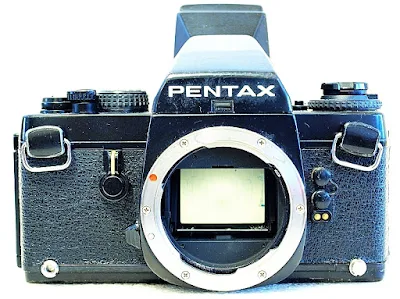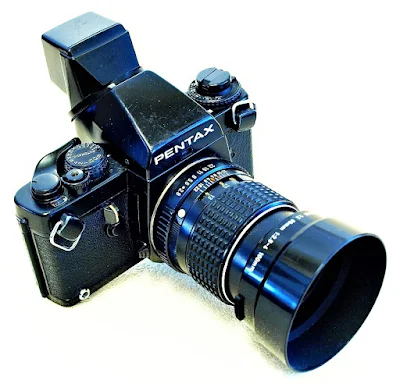The Pentax LX 35mm SLR film camera, produced between 1980 to 2001x, was the most advanced professional or system camera of the Pentax manual focus range. The camera was launched by Pentax as a 'professional' system camera, augmented with options and accessories including detachable prisms, backs, winders, focusing screens, attachable handles, and even special limited releases in Gold and Titanium. The camera was the first dust- and moisture-proof SLR body with seals on every button and dial.
Operationally, the LX is fitted with an electro-mechanical horizontal run titanium focal plane shutter with a shutter speed range from 1/2000 second down to 4 seconds, and B. Shutter speeds set manually from 1/2000 down to X on the shutter speed dial can still be used even if the camera's batteries are depleted. In the 'Automatic' mode selection, shutter speeds are step-less, and will not operate without battery power. 'X' flash sync is at 1/65 second. The LX accepts film ISO speed settings from 6 to 3200.
Exposure control is manual or aperture priority automatic, with exposure compensation at 1/3 EV steps. The shutter release is lockable. The exposure meter is battery-dependent. The LX also came with a multi-function lever that supports mirror lock-up and depth of field preview. Multiple exposures are enabled by pressing the film rewind button and advancing the film forward crank.
Pentax LX Video Manual 1 of 2
Pentax's LX was, for most people, the gold-standard in professional, system camera for manual focus bodies. With a 21-year production life, the LX remained i...
Design and Build
Built along the line of the small and compact size of Pentax M series bodies, said to be the smallest 35 mm SLR film camera ever made, the LX is constructed out of a solid cast metal frame with metal covering plates, with black chrome coating under its black paint finish. Throughout production, the Pentax LX was produced in two iterations, normally referred to as the 'early' and 'later' models.The LX was also said to have been updated at least three times, but attempts to gather information about serial numbers and design variations are inconclusive.
Special releases of the LX include the Pentax LX Gold in 1981 to celebrate Pentax's production of 10 million SLR film cameras, the Pentax LX Titanium in 1994 to mark the company's 75th anniversary, a limited edition of 300 units of black finish Pentax LX Titanium in 1996, and the Pentax LX 2000 with an SMC Pentax-A 50mm F1.2 lens in bright metal finish marked the new millennium in 2000.
Basic Camera Features
With the interchangeable viewfinder options, one that stands out is the FB1 System Finder base, which allows for the mounting of 3 separate eyepieces - the FC-1 Action Eyepiece, the FD-1 Magni-Eyepiece, and the FD-2 Standard Eyepiece.The FC-1 Action Eyepiece (as shown) provides not only a magnified and elevated action viewpoint, but it can also be rotated 180 degrees to function as a waist-level viewfinder. The finder has no flash hot-shoe or dioptre correction but does have an aperture preview window.
The first thing you might notice about the front plane of the LX is the absence of the lug-strap anchors that are normally found close to the top corners of SLRs and other cameras. These have been replaced, instead, by a grip mount socket and an accessory lug on the bottom and top corners of the left front of the camera, and a pair of accessory lugs, one on each upper and lower corners of the right front of the camera body.
The arrangement of these sockets and lug points gives you the option of attaching the carry strap of the camera horizontally or vertically (when the left pair of sockets and lugs is already used for attaching the optional finger grip).
Other than that, there is the mandatory lens mount housing slightly off-center to the right of the camera front, supported by the Self-Timer/Depth of Field Preview/Mirror Lock selector located high towards the front of the top plane to the left of the mount, and the lens release button located on the south-west peripheral of the lens mount circle. Just off to the right of the lens mount housing is the pair of vertically lined X-synch and FP terminals, and auto flash contacts below it.
On the top plane of the camera, right to the left is the combination of the rewind crank, which is also the pull-up film back release, and the exposure compensation and film ISO speed dials. The exposure compensation dial is adjusted by first pressing the dial interlock button on the west outer edge of the dial and then rotating the dial to its desired setting. The film ISO speed is set by pulling up and rotating the outer crown of the combination dial. The film ISO speed is a panel display on the lower part of the top edge of the combination dial.
Next to the combination dial, just slightly forward of the edge of the top plane, is a push-and-turn lever set used for releasing the interchangeable viewfinder, located to its right.
On the right of the top plane is the cluster that includes the shutter speed dial, shutter release button, film forward crank, and frame counter window.
On the back of the camera body is the viewfinder eyepiece, which is part of the interchangeable viewfinder setup, and across the lower part is the film back itself, with a memo tab located centrally. In the middle of the lower edge of the film back is a pair of contacts for the databack.
On the bottom plane, from left to right with the camera facing forward, the film transport coupler access, film transport rate control coupling socket, film rewind release/multiple exposure button, tripod socket, battery chamber with its access cover, automatic advance contacts, and auto film rewind coupling.
Film loading and rewinding is, again, a typical procedure similar to what we have seen and done on other SLR film cameras. The same two blank shots bring the unexposed part of the film roll to frame 1.
Viewfinder Readout
The exposure display, on the right of the screen, will show a vertically aligned static display of numerals of the shutter speed, plus 'A' and 'B' on the inside of the viewscreen, plus a red flag for underexposure, and a blue needle to indicate the shutter speed, or approximate when shooting in 'Automatic', selection.
The row of colored LEDs alongside the shutter speed numerals is for indications of other active or warning modes - a red LED when lit, for overexposure, green LEDs for shutter speeds set between 1/2000 down to 1/125 second, an 'X' red LED for automatic flash synchronization and flash ready setting, yellow LEDs for shutter speeds set between 1/15 down to 4 seconds, and a red LED at the LT.B numerical location to indicate 'B' shutter setting and long exposure in 'Automatic' mode.
Automatic Shooting Mode
The norm of using the Pentax LX is to shoot in automatic exposure control or aperture-priority mode. This is done by setting the shutter speed dial to lock at 'Automatic' and by adjusting the lens aperture opening to the value you want to shoot in. The LX will read the exposure off the film plane and select the precise shutter speed from 1/2000th second down to 125 seconds for proper direction.The approximate speed selected will be indicated on the viewfinder display.
Manual Exposure Control
To set the LX for manual exposure control, press the shutter dial lock release at the edge of the 'Automatic' shutter speed location, and rotate the dial to the shutter speed position you want to shoot in. The speed selected will be displayed in the camera viewfinder by a blue flag on the shutter speed bar.Self-Timer/Depth of Field Preview/Mirror Lock
Self-TimerThe self-time of the Pentax LX provides a variable 4 to 10-second delay of the shutter release. To activate, press the lever release button and turn the multi-function lever counter-clockwise to approximate the time-lapse required.
The delay is actuated when the shutter is released. The timer can be canceled before the start of its run by returning the lever to its original position.
Depth of Field Preview
To preview the depth of the field, move the multi-function lever clockwise toward the lens mount. This will stop down the lens and the shooting aperture, allowing you to see the area of acceptable sharpness within the framed view.
Mirror Lock
The mirror lock on the Pentax LX is activated by simply pressing the lever release button and moving the multi-function lever clockwise toward the lens mount.
Multiple Exposures
The proviso of doing multiple exposure shots on the LX can be executed in a couple of ways, with the first option being to do a second exposure over the frame that you have shot. The second option is to use the random access feature provided by the camera to rewind the film frame back to a specific frame number to take the second shot.In the second routine, press the film rewind release/multiple exposure button and rewind the film to the frame you want to shoot over, with the lens properly capped, advance the film forward crank again, and take the shot.
In both instances, the advice is to preplan and take the shots with a manual shutter speed setting. This is to give you better exposure control over each of the layered images.
Battery
The Pentax LX requires the use of a pair of 1.5-volt LR- or SR44 button cells to operate. The batteries are still capable of powering the camera when the shutter speed LED glows continuously when the shutter button is half-pressed. The batteries need to be replaced when the LED indicators begin to flicker.Camera Body Weight
The body weight of the LX, with the standard FA-1 finder, is 570 grams. The body form of the LX is physically much smaller and lighter than the likes of the Canon F-1 or the Nikon F3.Pentax LX Sticky Mirror Syndrome
The Pentax LX sticky mirror syndrome, widely reported across the internet, is a problem that may and will eventually affect each and every LX over time. The most common cause, it seems, is when the mirror dampers have degraded and work more like a mush of sticky glue rather than their original function as a shock damper. There is also a lesser-reported problem that this problem may be caused by a faulty circuit board.With any of these problems, the best way out is to have the camera repaired, serviced, or CLA'd (Cleaned, Lubed, and Adjusted) by professionals or reputable and experienced technicians. Repair and service of these ailments are not as easy as they seem.
Options and Accessories
Besides the optional availability of 12 interchangeable focusing screens and five viewfinders already mentioned, immediate accessibility to the Pentax LX can also be seen in the form of the hand-contoured finger grips, the Winder LX, Motor Drive LX, Dial Data LX, and Watch Data LX data backs.The options, of course, include the range of over 40 Pentax SMC-M lenses all the way from 15mm ultra-wide-angle to 2000mm super-telephoto and an assortment of special-purpose lenses, including eight zooms, plus fisheye, macro, bellows, and shift lenses. All SMC-M lenses feature the exclusive Super-Multi-Coating for flare reduction, better light transmission, and better image resolution, contrast, and color balance.


























Excellent LX article!
ReplyDeleteThank you!
Delete